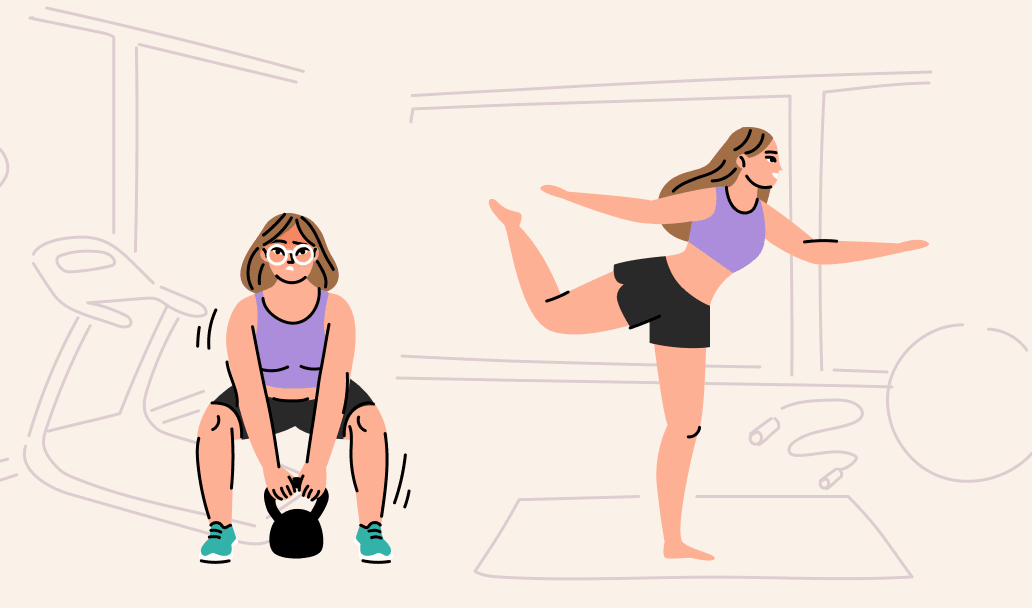Pilates and yoga have a lot of supporters around the world, due to the benefits they provide to the body. Improving flexibility, increasing endurance, forming a better body shape - they give the same results as the most challenging workouts, but without sweating. So what better to choose: pilates or yoga? Or are they the same? Let's figure it out.
Pilates and yoga are welcoming for everyone, regardless of your level of physical preparation. Both can be especially a good choice for beginners because they are kind of relaxing low impact and low intensity training, so they don't cause severe complications, and you don't risk injury at the start.
Eat tasty food and lose weight with Unimeal app!
Take a Quiz – Get personal meal plan – Achieve your weight goals!
Start Quiz
Slow down, feel your body, and breathe. Yoga and pilates have in common that they use a mate, promote weight loss, improve flexibility and endurance, and focus on the mind-body connection. It means they train not only your body but also facilitate mental and physical health. But the main difference between yoga and pilates is the technique of performing. In yoga you have to stand in the pose and hold it statically to feel more deeply, by comparison, in pilates, you stand in the pose to challenge your core.

Even though yoga and pilates are often placed in the same category, they have some key differences. If you have doubts about which one is better to start, make a choice according to your personal purpose.

Choose pilates.
The initial goal of both of them, pilates and yoga, is not about weight reduction. They are not as effective as cardio exercises and can`t help you to shed kilos quickly. Pilates and yoga work as the body sculptor of your muscles, not a magical pill against the fat layer. Anyway, training can contribute to further weight loss. If you want to burn more calories, you should prefer pilates.

Do exercises with minimal rest and additional sports equipment like blocks, fitness balls, or straps to increase the load on your muscles. Pilates mat class burns approximately 175 calories1American Council on Exercise January 01, 2006 Can Pilates Do It All? American Council on Exercise Retrieved from https://www.acefitness.org/getfit/PilatesStudy2006.pdf at the beginner level, and up to 254 calories at the advanced level. In a group training or alone with a personal pilates instructor, combine your active regular classes with a balanced diet to achieve noticeable results.

Choose yoga.
Yoga consists of meditation and breathing techniques, thus uniting the mind and body. As a result, it calms down the level of stress, reducing anxiety and depression. Regular yoga practice will help you to create a sense of well-being and switch a pessimistic vision of life to an optimistic one.
Yoga's ability to increase relaxation and induce a balanced mental state was studied to evaluate its effect on sleep quality and improve insomnia. Regular yoga practice resulted in a significant decrease in the time taken to fall asleep, an increase in the total number of hours slept, and the feeling of being rested in the morning2Woodyard C. 2011 Jul-Dec Exploring the therapeutic effects of yoga and its ability to increase quality of life. Int J Yoga. PMID:22022122.
Choose pilates.
If yoga was primarily invented as a spiritual discipline for controlling and stilling the mind, pilates was developed during World War I to help injured soldiers restore health. That's why it aims to alleviate some health problems, such as lower back pain.
Pilates exercises focus on core stability and strengthen the muscles of the back. If you have chronic pain that impairs your movement or probably some back injuries, choose this kind of sport. A pilates trainer can find specific poses necessary to reduce trauma's pain or effects, and even restore a poor posture.

It is difficult to answer whether pilates or yoga is easier. It depends on your coordination, physical preparation, and body ownership. For beginners, it is better to learn pilates or yoga with an instructor, not from YouTube. A qualified specialist can find the best poses for your posture and level of training, limit or increase physical exertion, and also correct your poses. After you learn the basics, you can move on to a more difficult level and practice at home on your own.
Unimeal does not diagnose or suggest treatments. Any description of the diet, training plan or supplement should be discussed with your current physician or nutritionist. This article does not address specific conditions and is simply meant to provide general information on healthcare topics. Following any advice is at your own initiative and does not impose any responsibility on the blog authors for your health and safety.
Sources:
By choosing high-quality sources, we make sure that all articles on the Unimeal blog are reliable and trustworthy. Learn more about our editorial processes.
1.
2.